 
Weekly Feature - Aug 20 1999
Previous Week
Templenet Archives
Encyclopedia of Indian Temples
Indian Temple Architecture Travel and
Tourism (Maps)
Festivals and Fairs
Beliefs and Legends
Glossary of Terms
Templenet - The Ultimate Source of
Information on Indian Temples
Karnataka Tourism
The Karnataka Website
Bangalore Net
Map of Karnataka
Ministry of Tourism - India
Feedback & Information:
webmaster@templenet.com
©1996 K. Kannikeswaran
All Rights Reserved.
Templenet
where
Tradition Meets Technology
|
|
Belur - A Temple
Retreat
Text and Images: Shruti Nanavaty
Some of the most magnificent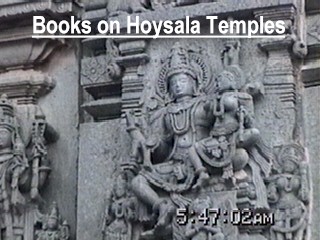 specimens of South Indian temples are those attributed to the Hoysala dynasty of
Karnataka. How this powerful dynasty got its name is a tale that must have been narrated
time and again. Hoy Sa'la meaning "strike Sa'la!", were the words spoken
to Sa'la ( legendary head of this dynasty) to kill the tiger. Since Sa'la tackled the
tiger single-handed and killed him, this heroic deed took the form of the dynasty's name.
The rulers of this clan were called the Yadava Kings who ruled with tremendous power after
having defeated the Chalukyas and rose above all to become the paramount rulers even over
the Cholas and Pandyas in South India. The Hoysala dynasty originally had their capital at
Halebid (about 17 kms from Belur) where they ruled for over 150 years. However, it was
attacked by invaders a couple of times during the 14th century, reducing the once grand
capital to poverty and ruins. Thus, the Hoysalas shifted their seat of power to Belur
which stood proud as a powerful empire back then.
specimens of South Indian temples are those attributed to the Hoysala dynasty of
Karnataka. How this powerful dynasty got its name is a tale that must have been narrated
time and again. Hoy Sa'la meaning "strike Sa'la!", were the words spoken
to Sa'la ( legendary head of this dynasty) to kill the tiger. Since Sa'la tackled the
tiger single-handed and killed him, this heroic deed took the form of the dynasty's name.
The rulers of this clan were called the Yadava Kings who ruled with tremendous power after
having defeated the Chalukyas and rose above all to become the paramount rulers even over
the Cholas and Pandyas in South India. The Hoysala dynasty originally had their capital at
Halebid (about 17 kms from Belur) where they ruled for over 150 years. However, it was
attacked by invaders a couple of times during the 14th century, reducing the once grand
capital to poverty and ruins. Thus, the Hoysalas shifted their seat of power to Belur
which stood proud as a powerful empire back then.
At a distance of about 220 Kms from the metro
city of Bangalore, Belur is considered as the Banaras of South and is thus also known as Dakshina
Varanasi. A small town located on the banks of River Yagachi , it is but very popular
for its marvellous temples which are among the best if one wants to study temple
architecture. They are an architectural delight and one can spend days drinking in their
beauty. The Hoysalas were brilliant builders who developed a new style of temple architecture. They conceived their shrines as star-shaped
structures and not the usual cubical form. In this concept of the stellate, the main
temple at Belur, is a show-stealer. Among the Hoysala rulers, King Vishnuvardhana who was
also responsible for defeating the Chalukyas, built this impeccable masterpiece of a
temple. The serenity of Belur is attributed to the celebrated temple of Channakeshava.
According to inscriptions, the temple was built to commemorate his conversion from Jainism
to Vaishnavism. He signalised his conversion by the erection of many temples of
unsurpassed excellence, of which the temple of Chennakesava was no doubt the best. There
is also another version where the temple is said to have been built to celebrate King
Vishnuvardhana's victory of Talkad over the Cholas.
Before learning about the major assets of the
Channakeshava Temple, it is essential to understand that the temples built in those days
were not just limited to the cause of worship and religion. Infact a temple was built for
five reasons, where apart from religion, it provided scope for a justice court, a treasure
house, an institution to impart ethical education and fostered our various arts including
music and dance.
The first thing that catches
one's eye, is the beautiful ornamental Gopuram of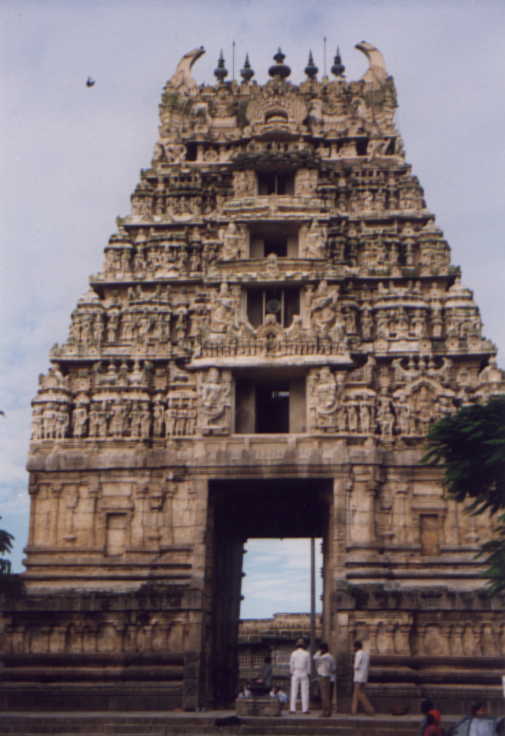 the
Channakeshava Temple. It stands tall , giving a feeling that one is entering a
grandiose royal court. As one steps onto the temple's sacrosanct platform, in a corner of
the vast courtyard are tossed a golden horse and a temple chariot. The winged figure of
Garuda, Lord Vishnu's carrier, stands at the entrance, facing the temple, its palms
touching in homage. The main structure of the temple, which is a stellar, stands as a
homogenous architectural unit on a raised platform. The entire structure with its
intricate Filigree gleams like metal. Chloritic Schist, a light greenish soapstone, hard
as granite was used to create the complex. Every possible surface is covered with the most
perfectly proportioned figures. The main temple is surrounded by other small ones such as
those of Soumyanayaki and Ranganayaki, beloved of Sri Chennakesava. the
Channakeshava Temple. It stands tall , giving a feeling that one is entering a
grandiose royal court. As one steps onto the temple's sacrosanct platform, in a corner of
the vast courtyard are tossed a golden horse and a temple chariot. The winged figure of
Garuda, Lord Vishnu's carrier, stands at the entrance, facing the temple, its palms
touching in homage. The main structure of the temple, which is a stellar, stands as a
homogenous architectural unit on a raised platform. The entire structure with its
intricate Filigree gleams like metal. Chloritic Schist, a light greenish soapstone, hard
as granite was used to create the complex. Every possible surface is covered with the most
perfectly proportioned figures. The main temple is surrounded by other small ones such as
those of Soumyanayaki and Ranganayaki, beloved of Sri Chennakesava.
There are also temples built for Narasimha,
Anjaneya, etc. King Vishnuvardhana's senior queen Shantaladevi, a dance legend herself,
built a temple in similar fashion to the main temple, which was called the Channigaraya
temple.
The surface of the temple exterior is
intricately filled with horizontal friezes, sculptured in succession from the bottom.
Stories from the Puranas, Upanishads and other mythological stories have been executed in
the most authentic way. The
Ramayana and the Mahabharata also have been
included. There are also friezes of a variety of creepers and cornices with bead work .
The lowest frieze is that of a series of 650 charging elephants around the walls and are
all different from each other. They symbolise stability and tremendous strength and
are considered the weight lifters of the temple. Next come the lions which symbolise
courage while the horses above them are for speed. The creepers signify beauty. Thus,
every piece of work is significant, having a meaning.
As you look up at the corners of the temple
exterior, you are left spellbound at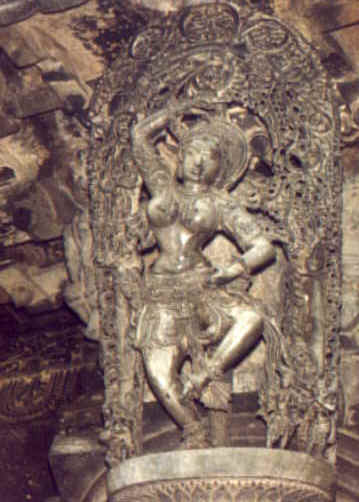 the ultimate
sculptural beauties, that adorn it. The bracketed figurines called the Madanikas or
celestial nymphs are no doubt the highlight of the temple's magnificant architecture.
Exclusive to Belur, the Madanikas lift the glory of the temple to unprecedented
heights of excellence. And there are as many as 42 of them, of which 38 adorn the exterior
walls while the remaining four are placed inside on the ornate ceiling. The Madanikas
are said to be inspired by the beautiful Queen Shantaladevi, epitomising the ideal
feminine form. The variety of poses and subjects that these represent is something to
marvel about. Each depicts a mood and all are amorous. 'The Beauty with a mirror-Darpana
Sundari', 'The lady with the parrot', 'The Huntress', 'The Bhasma-Mohini' are
some of the favourites. All these and more are carved with utmost care and clinical
precision, making them come alive. the ultimate
sculptural beauties, that adorn it. The bracketed figurines called the Madanikas or
celestial nymphs are no doubt the highlight of the temple's magnificant architecture.
Exclusive to Belur, the Madanikas lift the glory of the temple to unprecedented
heights of excellence. And there are as many as 42 of them, of which 38 adorn the exterior
walls while the remaining four are placed inside on the ornate ceiling. The Madanikas
are said to be inspired by the beautiful Queen Shantaladevi, epitomising the ideal
feminine form. The variety of poses and subjects that these represent is something to
marvel about. Each depicts a mood and all are amorous. 'The Beauty with a mirror-Darpana
Sundari', 'The lady with the parrot', 'The Huntress', 'The Bhasma-Mohini' are
some of the favourites. All these and more are carved with utmost care and clinical
precision, making them come alive.
On entering the interiors of the
Channakeshava temple, at the entrance one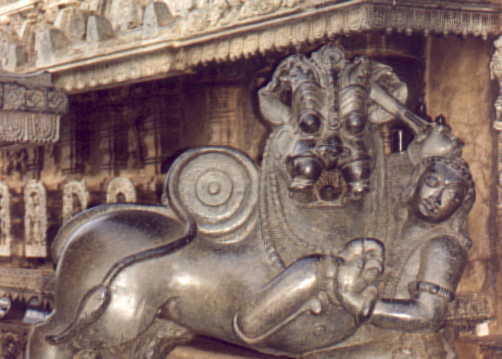 cannot help pausing a moment to look at the
trademark of the temples of Hoysa'la dynasty, the royal emblem. The story of
"Sa'la" killing the tiger as though comes to life. He has been
immortalised along with the tiger and thus this heroic act has became the royal emblem of
the Hoysala dynasty. This emblem is found at the entrance of almost all their temples. cannot help pausing a moment to look at the
trademark of the temples of Hoysa'la dynasty, the royal emblem. The story of
"Sa'la" killing the tiger as though comes to life. He has been
immortalised along with the tiger and thus this heroic act has became the royal emblem of
the Hoysala dynasty. This emblem is found at the entrance of almost all their temples.
If the temple's exteriors are out of this
world, it is almost impossible to describe the greatness of its interiors which is even
superior architecturally speaking. The presiding deity is the manifestation of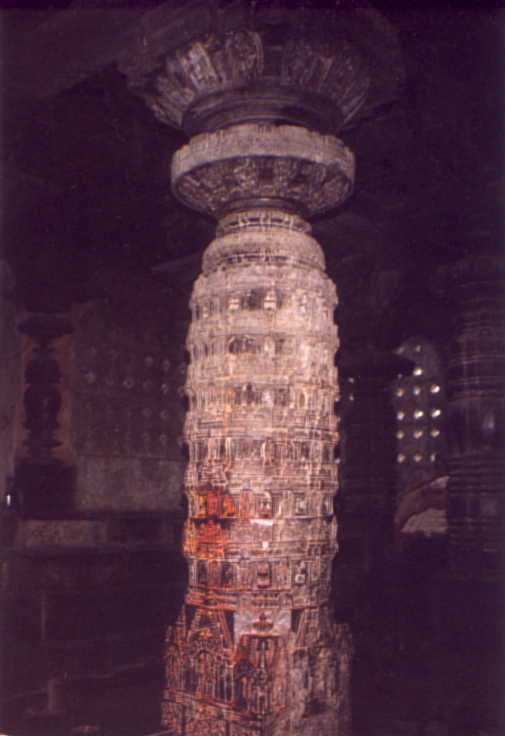 Lord Krishna or Keshava and is called 'Vijaya Narayana' here. The
beautiful image stands six feet tall and was installed in the sanctum of the main temple
in 1117 A.D. There are about 48 pillars of various sizes, shapes and designs , bearing
testimony to remarkable artistry. Inside, even in the darkness, you can see the shining
pillars, each unique in its own splendour. The most popular being,
the Narasimha pillar in the Navaranga, unique
in its filigreed splendour. It is said to have revolved on its ball bearings once.
A small space has been left on it to be sculpted by anyone who has the talent. It remains
untouched. The Mohini Pillar also deserves a special mention which has been carved
with great care and proportion. Here again, the spotlight is forever focussed on the four Madanikas
on the ceiling. Lord Krishna or Keshava and is called 'Vijaya Narayana' here. The
beautiful image stands six feet tall and was installed in the sanctum of the main temple
in 1117 A.D. There are about 48 pillars of various sizes, shapes and designs , bearing
testimony to remarkable artistry. Inside, even in the darkness, you can see the shining
pillars, each unique in its own splendour. The most popular being,
the Narasimha pillar in the Navaranga, unique
in its filigreed splendour. It is said to have revolved on its ball bearings once.
A small space has been left on it to be sculpted by anyone who has the talent. It remains
untouched. The Mohini Pillar also deserves a special mention which has been carved
with great care and proportion. Here again, the spotlight is forever focussed on the four Madanikas
on the ceiling.
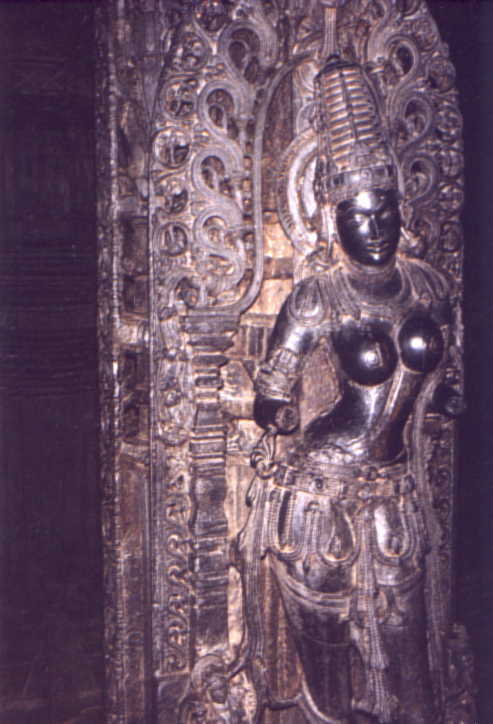 If one is willing to spend enough
time at Belur, there is no end to the pleasures one experiences in gazing at the different
mythological tales that these time-tested monuments have to narrate. The temples create
magic during the early hours of the day, just before sunrise, when a tranquil atmosphere
surrounds them. This is the best time to enjoy and understand the poetry of these stone
images. The transition from dawn to after sunrise is also something not to be missed.
Suddenly the temple brightens up bringing with it the liveliness of the local devotees,
who begin to throng in, as part of a daily ritual. A total different mood sets in, that of
colour and light. If one is willing to spend enough
time at Belur, there is no end to the pleasures one experiences in gazing at the different
mythological tales that these time-tested monuments have to narrate. The temples create
magic during the early hours of the day, just before sunrise, when a tranquil atmosphere
surrounds them. This is the best time to enjoy and understand the poetry of these stone
images. The transition from dawn to after sunrise is also something not to be missed.
Suddenly the temple brightens up bringing with it the liveliness of the local devotees,
who begin to throng in, as part of a daily ritual. A total different mood sets in, that of
colour and light.
[Temples of Karnataka][The Templenet Encyclopedia -
Index to States]
|


 the
the the ultimate
sculptural beauties, that adorn it. The bracketed figurines called the Madanikas or
celestial nymphs are no doubt the highlight of the temple's magnificant architecture.
Exclusive to Belur, the Madanikas lift the glory of the temple to unprecedented
heights of excellence. And there are as many as 42 of them, of which 38 adorn the exterior
walls while the remaining four are placed inside on the ornate ceiling. The Madanikas
are said to be inspired by the beautiful Queen Shantaladevi, epitomising the ideal
feminine form. The variety of poses and subjects that these represent is something to
marvel about. Each depicts a mood and all are amorous. 'The Beauty with a mirror-Darpana
Sundari', 'The lady with the parrot', 'The Huntress', 'The Bhasma-Mohini' are
some of the favourites. All these and more are carved with utmost care and clinical
precision, making them come alive.
the ultimate
sculptural beauties, that adorn it. The bracketed figurines called the Madanikas or
celestial nymphs are no doubt the highlight of the temple's magnificant architecture.
Exclusive to Belur, the Madanikas lift the glory of the temple to unprecedented
heights of excellence. And there are as many as 42 of them, of which 38 adorn the exterior
walls while the remaining four are placed inside on the ornate ceiling. The Madanikas
are said to be inspired by the beautiful Queen Shantaladevi, epitomising the ideal
feminine form. The variety of poses and subjects that these represent is something to
marvel about. Each depicts a mood and all are amorous. 'The Beauty with a mirror-Darpana
Sundari', 'The lady with the parrot', 'The Huntress', 'The Bhasma-Mohini' are
some of the favourites. All these and more are carved with utmost care and clinical
precision, making them come alive. cannot help pausing a moment to look at the
trademark of the temples of Hoysa'la dynasty, the royal emblem. The story of
"Sa'la" killing the tiger as though comes to life. He has been
immortalised along with the tiger and thus this heroic act has became the royal emblem of
the Hoysala dynasty. This emblem is found at the entrance of almost all their temples.
cannot help pausing a moment to look at the
trademark of the temples of Hoysa'la dynasty, the royal emblem. The story of
"Sa'la" killing the tiger as though comes to life. He has been
immortalised along with the tiger and thus this heroic act has became the royal emblem of
the Hoysala dynasty. This emblem is found at the entrance of almost all their temples. Lord Krishna or Keshava and is called 'Vijaya Narayana' here. The
beautiful image stands six feet tall and was installed in the sanctum of the main temple
in 1117 A.D. There are about 48 pillars of various sizes, shapes and designs , bearing
testimony to remarkable artistry. Inside, even in the darkness, you can see the shining
pillars, each unique in its own splendour. The most popular being,
the Narasimha pillar in the Navaranga, unique
in its filigreed splendour. It is said to have revolved on its ball bearings once.
A small space has been left on it to be sculpted by anyone who has the talent. It remains
untouched. The Mohini Pillar also deserves a special mention which has been carved
with great care and proportion. Here again, the spotlight is forever focussed on the four Madanikas
on the ceiling.
Lord Krishna or Keshava and is called 'Vijaya Narayana' here. The
beautiful image stands six feet tall and was installed in the sanctum of the main temple
in 1117 A.D. There are about 48 pillars of various sizes, shapes and designs , bearing
testimony to remarkable artistry. Inside, even in the darkness, you can see the shining
pillars, each unique in its own splendour. The most popular being,
the Narasimha pillar in the Navaranga, unique
in its filigreed splendour. It is said to have revolved on its ball bearings once.
A small space has been left on it to be sculpted by anyone who has the talent. It remains
untouched. The Mohini Pillar also deserves a special mention which has been carved
with great care and proportion. Here again, the spotlight is forever focussed on the four Madanikas
on the ceiling.  If one is willing to spend enough
time at Belur, there is no end to the pleasures one experiences in gazing at the different
mythological tales that these time-tested monuments have to narrate. The temples create
magic during the early hours of the day, just before sunrise, when a tranquil atmosphere
surrounds them. This is the best time to enjoy and understand the poetry of these stone
images. The transition from dawn to after sunrise is also something not to be missed.
Suddenly the temple brightens up bringing with it the liveliness of the local devotees,
who begin to throng in, as part of a daily ritual. A total different mood sets in, that of
colour and light.
If one is willing to spend enough
time at Belur, there is no end to the pleasures one experiences in gazing at the different
mythological tales that these time-tested monuments have to narrate. The temples create
magic during the early hours of the day, just before sunrise, when a tranquil atmosphere
surrounds them. This is the best time to enjoy and understand the poetry of these stone
images. The transition from dawn to after sunrise is also something not to be missed.
Suddenly the temple brightens up bringing with it the liveliness of the local devotees,
who begin to throng in, as part of a daily ritual. A total different mood sets in, that of
colour and light.